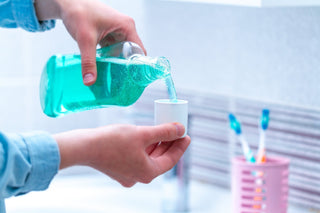What is Mouthwash?
When it comes to maintaining good oral hygiene, brushing and flossing often take the spotlight—but what about mouthwash? That mysterious bottle tucked away on bathroom shelves across the globe holds more power than you might realise. So, what exactly is mouthwash, and why should it become part of your daily routine?
Mouthwash, also known as an oral rinse, is a liquid solution designed to complement your oral hygiene routine. It’s not meant to replace brushing and flossing but rather to act as an additional step for a cleaner, fresher mouth. Mouthwash typically contains a combination of ingredients that help target bacteria, reduce plaque, freshen breath, and sometimes even strengthen teeth. Mouthwash is great for the oral microbiome.
How to Use Mouthwash
Mouthwash—whether it’s for fresh breath, plaque control, or cavity prevention—can be a powerful addition to your oral hygiene routine. However, using it correctly is key to unlocking its full potential. Here’s a step-by-step guide to help you get the most out of your mouthwash.
Step 1: Choose the Right Mouthwash
Not all mouthwashes are the same. Select one that suits your needs:
- For fresh breath: A cosmetic mouthwash works wonders.
- For cavity prevention: Opt for fluoride-based rinses.
- For healthier gums: An antibacterial or antiseptic formula is your best friend.
-
For a NATURAL approach: Look for alcohol-free or herbal options.
Step 2: Read the Instructions
Every bottle of mouthwash comes with specific instructions, so give them a quick read. Some formulas require dilution, while others are ready to use. The recommended time for swishing is usually printed on the label as well.
Step 3: Measure the Right Amount
Pour the recommended amount of mouthwash into the cap or a small cup. This is typically around 20–30 millilitres (about 4–6 teaspoons). Avoid overfilling to ensure you're not using too much.
Step 4: Swish, Gargle, and Don’t Rush
Take the mouthwash into your mouth and:
- Swish it around your teeth and gums for about 30 seconds. Make sure it reaches every corner of your mouth.
- If the instructions suggest gargling, tilt your head back slightly and let the liquid reach the back of your throat.
Pro tip: Set a timer or count silently to 30 in your head to ensure you’re swishing for the right amount of time.
Step 5: Spit It Out
Once the time is up, spit the mouthwash into the sink. Mouthwash is not meant to be swallowed, as it contains ingredients that are safe for rinsing but not for digestion.
Step 6: Wait Before Eating or Drinking
To get the most out of your rinse—especially if it contains fluoride—try not to eat, drink, or rinse your mouth with water for at least 30 minutes. This gives the mouthwash time to work its magic.
How Does Mouthwash Work?
Mouthwash contains a variety of active ingredients, each designed to tackle specific oral health concerns. Here’s how these components come into play:
- Antibacterial Agents: Ingredients like chlorhexidine, cetylpyridinium chloride (CPC), or essential oils attack harmful bacteria in your mouth. By reducing bacterial load, these agents help prevent gum disease, plaque buildup, and bad breath.
- Fluoride: In fluoride-based mouthwashes, this mineral strengthens enamel and makes teeth more resistant to decay, acting as a shield against cavities.
- Astringents and Aromatics: Ingredients like alcohol or natural oils provide that refreshing taste and clean sensation while helping to neutralize bad odours.
- Anti-inflammatory Agents: Some formulations include ingredients like aloe vera or chamomile extracts to soothe gum inflammation.
- Whitening Additives: In cosmetic mouthwashes, hydrogen peroxide or similar agents help reduce surface stains on teeth.
How Mouthwash Works Its Magic
Mouthwash works through a few simple yet effective mechanisms:
- Kills Bacteria: Most mouthwashes are designed to reduce the number of harmful bacteria in your mouth. By targeting bacteria in your teeth, gums, and tongue, they reduce the risk of plaque accumulation and bad breath (also known as halitosis).
- Freshens Breath: The flavouring agents and antibacterial properties in mouthwash combat odour-causing bacteria and leave your breath smelling fresh.
- Prevents Cavities: Fluoride rinses strengthen enamel and help remineralize early stages of tooth decay, making your teeth more resistant to acid attacks from food and drink.
- Reduces Plaque and Gum Inflammation: Antibacterial and anti-inflammatory agents lower plaque levels and calm irritated gums, helping to prevent gingivitis.
- Provides a Complete Clean: By reaching areas your toothbrush and floss might miss, mouthwash acts as a finishing touch to your oral hygiene routine.
Should I use Mouthwash Before or After Brushing?
The great debate: before or after brushing? The answer largely depends on the type of mouthwash you're using and your oral health goals. Here's a breakdown;
Using Mouthwash Before Brushing
- To loosen debris: Some people prefer to rinse with mouthwash before brushing to help dislodge food particles and plaque, making brushing more effective.
- For fresh breath upfront: A quick rinse can leave your mouth feeling fresh and prepped for the rest of your routine.
Using Mouthwash After Brushing (The preferred method by dentists)
- Brushing first removes surface debris: allowing the mouthwash to work directly on your clean teeth and gums.
- For fluoride-based rinses: Using fluoride mouthwash after brushing (and avoiding eating or drinking for 30 minutes) allows the fluoride to strengthen your enamel without being immediately rinsed away.
How Often Should You Use Mouthwash?
People often wonder should you use mouthwash everyday but how often should you use it?
Once or Twice a Day: Most over-the-counter mouthwashes can be used once or twice daily. Many people find it effective to rinse after brushing and flossing in the morning and/or at night.
For Fluoride Mouthwash - Once Daily: Fluoride mouthwash is usually recommended for daily use, especially before bedtime, to strengthen enamel and protect against cavities.
For Antiseptic Mouthwash - As Directed: Antiseptic mouthwash, often used to treat gum disease or after dental procedures, should be used as directed by your dentist. Overuse can irritate your mouth or disrupt the natural balance of oral bacteria.
Mouthwash Ingredients to Look For
Fluoride - Purpose: Strengthens enamel and prevents tooth decay. Great For: Those prone to cavities or tooth sensitivity.
Antibacterial Agents - Examples: Chlorhexidine, cetylpyridinium chloride (CPC), or essential oils (e.g., eucalyptus, thymol). Purpose: Reduces harmful bacteria, combats gum disease, and prevents plaque build-up. Great For: Managing gingivitis or improving overall gum health.
Alcohol - Purpose: Acts as a preservative and enhances antibacterial effects. Note: While effective, alcohol-based mouthwashes may cause dryness or irritation in some people. Alcohol-free options are available for sensitive users.
Whitening Agents - Examples: Hydrogen peroxide or carbamide peroxide. Purpose: Helps reduce surface stains on teeth over time. Great For: Those seeking a brighter smile.
Odour Neutralizers - Examples: Zinc salts or chlorine dioxide. Purpose: Neutralizes odour-causing compounds for fresh breath. Great For: Tackling persistent bad breath (halitosis).
Anti-inflammatory Ingredients - Examples: Aloe vera, chamomile extracts, or other herbal additives. Purpose: Soothes irritated gums and reduces inflammation. Great For: Sensitive gums or recovery from dental procedures.
Natural Ingredients - Examples: Tea tree oil, coconut oil, or xylitol. Purpose: Eco-friendly and gentle options for those who prefer natural oral care solutions. Great For: People seeking alcohol-free and herbal-based alternatives.
Are There Any Side Effects of Using Mouthwash?
-
Dry Mouth - Mouthwashes containing alcohol can sometimes lead to dryness in the mouth. This happens because alcohol can strip away natural moisture, leaving your mouth feeling parched.
-
Irritation or Sensitivity - Some people experience a burning sensation or irritation in the mouth, especially when using alcohol-based or strong antibacterial mouthwashes. This is more common if you have sores, cuts, or sensitive oral tissues.
-
Altered Taste - Certain mouthwashes, particularly those containing strong antiseptic agents like chlorhexidine, can temporarily alter your sense of taste. This usually resolves once you stop using the mouthwash.
-
Tooth Staining - Prolonged use of some antibacterial mouthwashes (e.g., chlorhexidine) can cause temporary brownish stains on teeth, especially if combined with foods and drinks that stain, like coffee or tea. Your dentist can remove these stains during cleaning.
- Disruption of Oral Microbiome - Overusing mouthwash can disturb the balance of good and bad bacteria in your mouth, potentially leading to issues like bad breath or increased susceptibility to infections.
-
Allergic Reactions - Although rare, some people may be allergic to certain ingredients, such as flavorings or preservatives, which can cause redness, swelling, or other symptoms.
-
Overexposure to Fluoride - Excessive use of fluoride mouthwash, especially in children, can lead to dental fluorosis (a condition that affects the appearance of tooth enamel).
How to Minimize Side Effects
Choose a mouthwash suited to your needs—alcohol-free options are available for sensitive users. Use it as directed on the label or as advised by your dentist—don’t overuse! If you notice persistent irritation or other side effects, stop using the mouthwash and consult your dentist.
Final Thoughts on Mouthwash
Mouthwash might not be the star of the show, but it certainly deserves consideration in your oral hygiene lineup. With its ability to fight bacteria, freshen breath, and protect your teeth, it’s a small addition that can make a big difference. Your mouth will thank you!
Click here for all your dental and natural oral care


